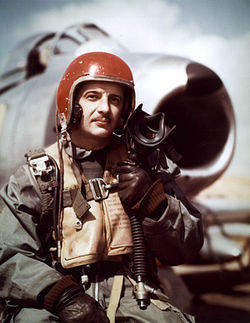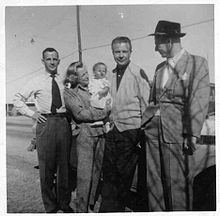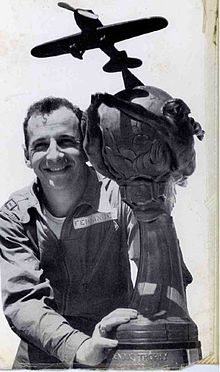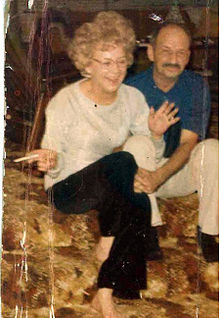- Manuel J. Fernandez
-
Manuel John Fernandez, Jr. 
Capt. Manuel J. Fernandez, Jr. of the 334th Fighter Intercepter Squadron, 4th Fighter Wing, became the 26th jet ace of the Korean War on February 18, 1953. He finished the war with fourteen and a half kills.[1]Nickname Pete Born April 19, 1925
Key West, FloridaDied October 18, 1980 (aged 55)
Grand Bahama Island, The BahamasAllegiance  United States of America
United States of AmericaService/branch  United States Air Force
United States Air ForceYears of service 1943–1963 Rank Major Unit 334th Fighter Interceptor Squadron, 4th Fighter Wing Battles/wars World War II
Berlin Airlift
Korean WarAwards Distinguished Service Cross
Silver Star
Air MedalOther work 1956 Bendix Trophy Air Race winner Manuel John "Pete" Fernandez (April 19, 1925 – October 18, 1980) was the third-leading American ace in the Korean War.
Contents
Early life
Pete Fernandez was born in Key West, Florida on April 19, 1925.[2] His grandparents emigrated from Spain and spent some years on the island of Cuba before finally arriving in the United States. Fernandez was raised in a working-class environment in Miami. His father, an early amateur radio enthusiast, became chief radio operator for Pan American World Airways. Pete grew up immersed in aviation and learned to fly before he could drive, earning his private pilot’s license at age fifteen.
Military career
In June 1943, at the height of World War II, Fernandez enlisted in the Army Air Corps as an eighteen-year-old private. Though small in stature and just a high school graduate, he became a flying officer through talent, determination and the enormous manpower needs of total war. In the first of many aerial teaching jobs, Fernandez served for the duration as a flight instructor in Texas and saw no action in the conflict. However, he served the next time a European war threatened during the 1948-1949 Berlin Airlift. His wing was sent to Germany to provide fighter cover for the slow transport aircraft that were the aerial supply operation's backbone. This duty involved occasional hair-raising games of "chicken" with the Russians, but no shots were exchanged. It was only after nearly a decade in uniform that Captain Fernandez finally experienced battle. His turn came in the Korean War, where during a nine-month tour in 1952-1953, he proved to be one of the best combat aviators of his generation.
Fernandez was a crack marksman, one the best in the Air Force at that time in the art of deflection shooting[citation needed]. Fernandez used stealth and cunning to stalk MiGs rather than attacking impetuously. His modus operandi in combat was to maneuver skillfully and trigger his guns only when he had attained an optimum firing position. Like all top aces in Korea, Fernandez routinely violated Chinese air space by crossing the Yalu River into Manchuria to hunt his elusive MiG quarry. Hehad a reputation for taking care of his comrades and not being reckless with his wingman's safety in pursuit of air victories[citation needed].
After Korea
Top Korea aces Joe McConnell and Pete Fernandez meet with President Dwight Eisenhower at the White House, May 1953
Prior to Capt Fernandez' going to the Korean War, he was an advanced instructor at Nellis Air Force Base Gunnery School in Las Vegas, NV. Fernandez wanted to be part of the action in Korea and several times requested a transfer to the war. At the time the Air Force was reluctant to send its best instructors, preferring they lead the severe training regimen ongoing at Nellis. His requests were denied. Finally in frustration, Fernandez decided to begin a disobedience program. He began showing up at 5:00 AM late, drunk, or sometimes AWOL. Ultimately the Air Force was forced into a choice, either court marshal him, or send him to Korea. They sent him to Korea where he could use his extreme talents as a fighter pilot.
In Korea he became the third highest ranking American ace with 14.5 kills. What is particularly interesting about this record is that he achieved it in a very short period of time, approximately nine months. On May 13, 1953 to his frustration he was ordered out of Korea. The Air Force was in the habit of sending its aces home early to protect them, and Fernandez was then its #1 ace. Fighter piloting in war frequently carries with it a sense of great competition among the best pilots. At the time Fernandez, with 14.5 kills, was ahead of both Major James Jabara, 14 kills, and Capt. Joseph McConnell, 13 kills. Fernandez had only been in Korea 9 months, while Jabara saw 28 months and McConnell 11 months of combat.
Five days following Fernandez departure, on May 18, 1953, Capt. McConnell flew two missions encountering more than 30 MiGs. It was this last day of his tour that he got three kills, moving him from 13 to 16, ahead of both Fernandez and Jabara. And on July 15, 1953 Jabara earned his last kill bringing his total to 15, 0.5 ahead of Fernandez. On his return to Nellis Fernandez lamented that had the Air Force permitted him the two additional months, he would have maintained his #1 spot. Such is was the state of their competition.
In the spring of 1953, Fernandez returned home at the same time as his friend Joe McConnell, the "ace of aces" who had finished the war with sixteen kills. The two fighter pilots enjoyed a hero’s welcome, and were feted in city after city with parades and ceremonial keys. The new president, Dwight Eisenhower, wanted to bask in their reflected glory and invited them for a private "debriefing" in the White House. The fighter pilots' next duty station was California. McConnell got into flight testing, a coveted billet for its excitement and career-enhancing potential, and was sent to newly-christened Edwards AFB. A major Hollywood production was in the works about Captain McConnell called Tiger In The Sky. Fernandez, stationed near Los Angeles at the time, was an obvious choice to be the film's technical advisor. This billet included flying many stunts. Movie production was gearing up for shooting when suddenly, the top ace was killed in a 1954 test accident. After this fatal Mojave crash, the film project was retitled The McConnell Story with the tragic ending added and released in 1955. It starred Alan Ladd and June Allyson as Joe and "Butch" McConnell, with a cinematic result more love story than war saga. The film's tale is made more poignant knowing the actors fell into their own star-crossed romance—both were married to other people—even as they portrayed forlorn lovers. Allyson diligently chronicled the whole story in her 1982 autobiography. Fernandez befriended Allyson on the set and after production ended, she and her husband, actor/director Dick Powell invited the ace and his family to their California ranch. There, Pete shared his battle experiences with filmmaker Powell, whose next project was a Korean War air combat picture entitled The Hunters and starring Robert Mitchum. Powell's final film was released to good reviews in 1958, and it contains much more realistic combat sequences than The McConnell Story. Fernandez and two other top Korea aces, James Jabara and Royal Baker, attended the premiere.
In 1956, Fernandez won aviation’s prestigious Bendix Trophy Race by maximizing his speed and fuel consumption with old tricks learned while at war over Korea and China. There was a level playing field in the 1956 Bendix run, as all six aviators in the competition were experienced Air Force fighter pilots riding the same mount, the USAF's newest fighter, the F-100 Super Sabre. The chosen route was Los Angeles to Oklahoma City, 1,118 miles from start to finish. Though aerial refueling was approved for the first time in race history, no USAF tanker planes were available, so the competing aviators did without. This situation made their pre-race calculations all the more critical, as there would be little margin for error. Pete stayed up late the evening before the event, meticulously plotting his flight profile to wring everything he could manage from each ounce of fuel[citation needed]. On August 31, the six aircraft lifted off from Victorville, California at dawn, one after another, with Fernandez leading the way. When Pete’s F-100 rolled past the finish line in Oklahoma City less than two hours later, there was just twenty gallons of fuel remaining in its tanks, enough to stay airborne about a minute. As in Korea, careful planning was critical to Fernandez’s Bendix triumph.
Pete Fernandez after winning the Bendix Trophy, August 31, 1956
After these colorful postwar achievements, the jet ace sought assignment to flight testing in an effort to make rank. As a reserve officer, Fernandez would be forced to leave the service after twenty years unless he was tracked for higher command and given a regular commission. Hence, there was significant career pressure to get promoted. Pete was chosen in 1957 to try out for Test Pilot School at Nellis Air Force Base, though with just a high school degree, he was underqualified and clearly getting a break due to his war record. Further complicating matters, Fernandez was hindered by a USAF campaign then underway to “professionalize” itself by weeding out officers who had no higher education. (Pete’s advancement from Miami teenager to military aviator had only been possible due to the Air Corps’ unique and massive 1942-1947 expansion from an auxiliary Army branch into a modern air service.) At Test Pilot School, the Floridian had arrived at a critical juncture that would change the rest of his life. Finding himself scholastically unprepared for the academic challenge (the TPS curriculum had just begun to emphasize aerospace engineering), Fernandez decided to cheat on one of the entrance requirements, a calculus research project, and was caught. This act sank his future with the Air Force permanently. Pete was subsequently posted as a recruiting officer in Miami, then shipped to Argentina as a military trainer. He retired with the rank of major upon reaching twenty years’ service in June 1963.
Civilian life
Once a civilian, the ace switched from fighter jets to multiengine propliners, but was unable to get work with the big passenger carriers due to his lack of a college education. Fernandez piloted Curtiss-Wright C-46 Commandos, Douglas C-47 Skytrains and bigger Douglas DC-6s and DC-7s with a variety of transport companies. Most of Pete's flying after he quit the military was done from a notorious ramshackle section of Miami International Airport known as Corrosion Corner. This infamous airdrome was home to a colorful array of fly-by-night cargo outfits, smugglers and Central Intelligence Agency(CIA) contract agents. Deciding it patriotic, and to get the adrenaline jolt he missed from his Air Force days, Fernandez plunged into this dangerous intrigue[citation needed]. In a mission whose details are still hidden in the shade, he was soon contracted by the CIA in 1965 to steal an unidentified aircraft (possibly a MiG-17) from an unidentified Latin American country (possibly Cuba)[citation needed]. He pulled off the heist and used the money he earned for the job to buy his first home, in the Perrine section of Miami, not far from Homestead Air Force Base. At Homestead, Pete was able to keep connected with old buddies, occasionally stopping in the officers’ club for a drink. There, he also cultivated a relationship with a CIA contract agent named Gerald P. Hemming that would greatly influence the future course of events[citation needed].
In 1972, Fernandez was contracted by the CIA to steal another Soviet-model aircraft, this time from Lima, Peru. To prepare for the job, he first cultivated a relationship with a Peruvian air force officer. This contact became his ticket onto the airbase's restricted tarmac area. The targeted plane was an Antonov-26, a model Fernandez had never seen before, let alone flown[citation needed]. The twin-engine turboprop was in itself unremarkable, but it contained a computer module that permitted its crew to drop cargo with extreme accuracy. The mission was successful[citation needed].
Fernandez’s constant crewmate while flying with three separate transport companies in the 1960s and 1970s (Argonaut Airlines, Airlift International and Conner Airlines) was Howard K. Davis, himself a paramilitary pilot who had flown guns to Raúl Castro during the 1957-1958 Cuban Revolution. After the Castro brothers took power in January 1959, Davis switched sides and began conspiring against them as a founding member of a private commando operation based in the Florida Keys called the Intercontinental Penetration force, or InterPen. A key comrade of Davis in InterPen was future Fernandez associate Gerry Hemming. Funded by the Mafia and the CIA, then allies in an endeavor to murder Fidel Castro, as well as ultra-rightwing American groups such as the Minutemen, InterPen trained Cuban exiles in guerrilla tactics for use in infiltrating their homeland on missions of sabotage and assassination. Years later, after InterPen had broken up, Davis flew cargo with Fernandez as his regular job, but was still secretly working on covert operations[citation needed].
Howard Davis' comrade in arms and fellow cofounder of InterPen, former Marine Gerry Hemming, would exert important influence over Pete Fernandez's final destiny. A strapping soldier of fortune and sometime CIA asset who was also an aviator, Hemming eventually got Fernandez involved in black operations in Peru, namely the 1972 Lima contract job stealing the Antonov for the CIA[citation needed]. Later, in the mid-1970s, Hemming pulled Fernandez into drug smuggling activity. Their goal in this hazardous work was to infiltrate Bahamas-Colombia trafficking networks and gather intelligence on them for a Miami federal antidrug task force. Casualty rates in clandestine dope runs were higher than they had been in combat squadrons in Korea. According to Hemming, he and Fernandez ultimately worked for the South Florida Drug Interdiction Task Force. This task force was based in Miami and included the Federal Bureau of Investigation, Drug Enforcement Agency, U.S. Customs and the Internal Revenue Service[citation needed].
During their years working for the South Florida Task Force in 1977-1980, the last years of Fernandez’s life, he and Hemming provided key intelligence to the feds that led to their breaking up the “Black Tuna Gang” in 1979, then the biggest Colombian marijuana smuggling ring in the United States[citation needed]. Under deep cover, the pilots also provided critical background information for other long running investigations, even when the actual busts occurred some time after Hemming and Fernandez had left the work.[citation needed] These later-bearing fruits included Operations Grouper, Banco and Tiberon, all coordinated by the DEA, and most importantly, Operation Greenback[citation needed].
In April 1980, Fernandez was imprisoned in a Colombian jail, an ordeal that lasted for seven weeks. He had been arrested in Barranquilla in a DC-6 that was "clean," though his crewmates were known to be involved in drug trafficking. He languished in rough conditions, using his jacket as a pillow on the concrete floor and surviving on plantains. Though Miami DEA agent Jim Harmon assured Pete’s wife Jill that his agency would get Fernandez home, nothing happened[citation needed]. In Gerry Hemming's opinion, it was probably better it turned out that way, for had the U.S. government come to Pete’s aid it could have blown his cover and he might well have never gotten out of Colombia alive. As it turned out, Jill Fernandez was compelled to use the family’s life savings to pay a “fine”--effectively a bribe—in order to get her husband released from the squalid Barranquilla cellblock before conditions there broke his health. Whatever confluence of emotions he felt after the Colombian ordeal, facts show that Fernandez soon began planning what would be his last mission. With financial assistance from an associate, Delta Air Lines pilot James Killough, he obtained a twin-engine Piper Geronimo for a cannabis run to Colombia and back via the Bahama Islands[citation needed]. The Piper’s stock engines were replaced with bigger ones, and the blunt nose was lengthened to carry more cargo. The factory landing gear was replaced with stronger struts and more durable tires meant for rough terrain. Finally, to extend the aircraft’s range, extra gas tanks were affixed below each wing[citation needed].
On the morning of October 17, 1980, Fernandez left Homestead Airport on his last flight, after telling his wife he would be transporting lobsters. Apparently, all went well with the marijuana pickup, but while flying alone on the return leg, laden with hundreds of pounds of “Colombian Gold,” Pete crashed and died in the early morning darkness of October 18 while attempting to land in a remote part of Grand Bahama Island[citation needed].
Former FBI agent Harold Copus, a South Florida Task Force veteran who recruited drug pilots as informants, says of the fliers he handled,
“We used to have a saying about them: there are old pilots and are bold pilots, but there are no old bold pilots. They were real cowboys, they would do things that were unbelievable! It was like the Wild West for them: bringing in drugs was like buying candy. The skies were full of these guys. And they went down. Fernandez crashed going into the Bahamas? A lot of guys crashed going into the Bahamas. We had reports of crashes in the Bahamas, we had reports of crashes in Jamaica. Crashing was part of their business. It’s what those guys did!”
Pete Fernandez and Gerry Hemming willingly flew these dangerous drug runs with no proof of their true identity hidden away in a government file, and paid a tremendous price for their decision. Fernandez died in disgrace while Hemming spent nearly a decade Florida prison nicknamed "The Rock."[citation needed] Why did these men commit major felonies without a guarantee somewhere of their true purpose? Hemming puts it simply: the identity of undercover informants were "being sold out the back door" by federal employees to Colombian narcotraffickers. In this he is correct. In that era, government agencies, especially the DEA, were ridden with security problems. Two DEA agents in Boston were selling the identity of informants directly to narcotraffickers, court testimony later revealed, as was an agent in Miami[citation needed]. The Miami office was particularly suspect: another DEA agent there, a supervisor who headed up Operation Grouper (which used intelligence provided by Hemming and Fernandez) was later convicted of drug dealing[citation needed].
Given such realities, which street-level operatives like Hemming and Fernandez were well aware of, these men chose to work under extreme deep cover to prevent Colombian traffickers from discovering their activities and retaliating against them or their families. Such undocumented operatives could be left to twist in the wind if their sponsors decide it convenient upon their exposure[citation needed]. When Pete suddenly died on Grand Bahama Island, it must have proved easier for federal agents who knew better to say nothing and let his death be simply drug-related[citation needed].
Fernandez' gravesite at Arlington National Cemetery
After Fernandez died, he received obituaries in the Miami Herald and the New York Times, both of which mentioned widespread rumors that held the old ace had been working undercover. He is buried at Arlington National Cemetery.
See also
- List of Korean War air aces
- Hispanics in the United States Air Force
Notes
- ^ Korean Aces The Department of Defense 50th Anniversary of the Korean War Commemoration. Retrieved October 3, 2006.
- ^ Manuel "Pete" Fernandez - The Search for the Hispanic Ace of the Korean War Acepilots.com, 2003. Retrieved October 3, 2006.
References
Government records
- Drug Enforcement Agency (DEA) investigative file #GFZE-80-9072 pertaining to Manuel John Fernandez, Jr. File was obtained through a Freedom of Information Act request.
- general Accountability Office. “DEA is Not Protecting National Security Information", GAO/IMTEC-92-31. February 19, 1992.
Military records
- “Operations in MiG Alley,” 4th Fighter Interceptor Group, Air Force Historical Research Agency (AFHRA), microfilm roll #MO288.
- “History of the 334th Fighter Interceptor Squadron,” History of the Fourth November 1952, AFHRA, microfilm roll #MO287.
- Far East Air Forces, General Order No. 244, May 21, 1953, AFHRA, microfilm roll #32076.
- FEAF Intelligence Roundup, September 1952- May 1953, AFHRA, microfilm roll #K7398.
Magazine articles
- Farmer, James H. “The Hunters.” Air Classics, June 1988.
- Davis, Larry. “The Unknown Ace.” Sabre Jet Classics, Summer 2004.
- Kusama, Maria. “Report From Manchuria: Russians Did Fight In Korea.” U.S. News and World Report, December 31, 1954.
- Schiller, Gerald. “Air Force Maverick.” Aviation History, November 2006.
- Zampini, Diego. “Clash of Titans Over Korea.” Aviation History, November 2005.
Newspaper articles
- Alden, Robert (May 19, 1953). "Sabres Score 12-MiG Bag in Day". The New York Times.
- Alden, Robert (May 31, 1953). "MiGs Lose To Art of U.S. Flying Men". The New York Times.
- Associated Press wire story (May 1, 1953). "Ran Short of MiGs, Fernandez Asserts". Miami Daily News.
- Associated Press wire story (May 23, 1953). "Two U.S. Aces Fly Home". The New York Times.
- Associated Press wire story (May 26, 1953). "2 Aces To Ask Ike For Combat". Miami Daily News.
- Felt, Truman (May 25, 1953). "Fernandez Wants Sleep, Not Praise". Miami Daily News.
- Fernandez, Charles (May 31, 1953). "Throngs Cheer Fernandez; Jet Ace Happy But Humble". Miami Herald.
- Haddigan, Michael (June 27, 1988). "The Kingpin and His Many Connections". Arkansas Gazette.
- Hedges, Stephen (November 19, 1987). "Covert War Was Made In Miami". Miami Herald.
- Hiaasen, Carl (August 27, 1982). "Federal Drug Agent Accused of Smuggling". Miami Herald.
- International News Service wire story (May 25, 1953). "Air Force Has Proof Caucasians Fly Korea MiGs". Miami Herald.
- Mallory, Rose (May 28, 1953). "Miami’s Jet Ace Was Popular Student". Miami Daily News.
- McAden, Fitz (November 17, 1980). "How A War Hero Strayed From the Paths of Glory". Miami Herald.
- Mobley, Radford (May 26, 1953). "Fernandez May Arrive Saturday, But Is ‘Leery of All That Fanfare". Miami Herald.
- Mobley, Radford (May 27, 1953). "Only Shortage Was MiGs". Miami Herald.
- Petit, Don (May 18, 1953). "Greeting Is Set For Fernandez". Miami Daily News.
- Petit, Don (May 30, 1953). "Fernandez Is Welcomed By Throngs At Airport". Miami Daily News.
- Petit, Don (May 31, 1953). "Modest Fernandez Shies From Credit For Heroic Deeds". Miami Daily News.
- Sosin, Milt (May 29, 1953). "Fernandez’ Father Arrives To Join Welcome For Hero". Miami Daily News.
- Stackelberg, Baroness (May 30, 1953). "Big Delegation Turns Out To Welcome Capt. Fernandez". Miami Daily News.
- United Press International wire story (May 26, 1953). "Aces May Ask Ike to Order Return to Finish Korea Job". Washington Post.
- United Press International wire story (May 27, 1953). "Battleship Shells Wonson 5 Hours; Five MiGs Felled in Korea". The New York Times.
- Thomas, Jo (October 27, 1980). "Korea Jet Ace Recalled as Modest Hero". The New York Times.
Books
- Dwiggins, Don, They Flew the Bendix Race. New York: J.B. Lippincott Co. 1965.
- Werrell, Kenneth P. (2005). Sabres over MiG Alley: The F-86 and the Battle for Air Superiority in Korea. Annapolis, MD: Naval Institute Press. ISBN 1-59114-933-9.
External links
- Brief biography through 1963 with two photographs
- Marriage announcement, Time, November 30, 1953
- Color photograph of Fernandez in Korea, "Sabres and Aces: These rare color images present some of the pilots and aircraft that made history in the Korean War", AIR FORCE Magazine, September 2006, p. 81.
Categories:- United States Air Force officers
- American military personnel of the Korean War
- 1925 births
- 1980 deaths
- American Korean War flying aces
- Recipients of the Distinguished Service Cross (United States)
- Recipients of the Silver Star
- Recipients of the Distinguished Flying Cross (United States)
- People from Florida
- United States Army Air Forces officers
- United States Army Air Forces pilots of World War II
- American military personnel of World War II
Wikimedia Foundation. 2010.






